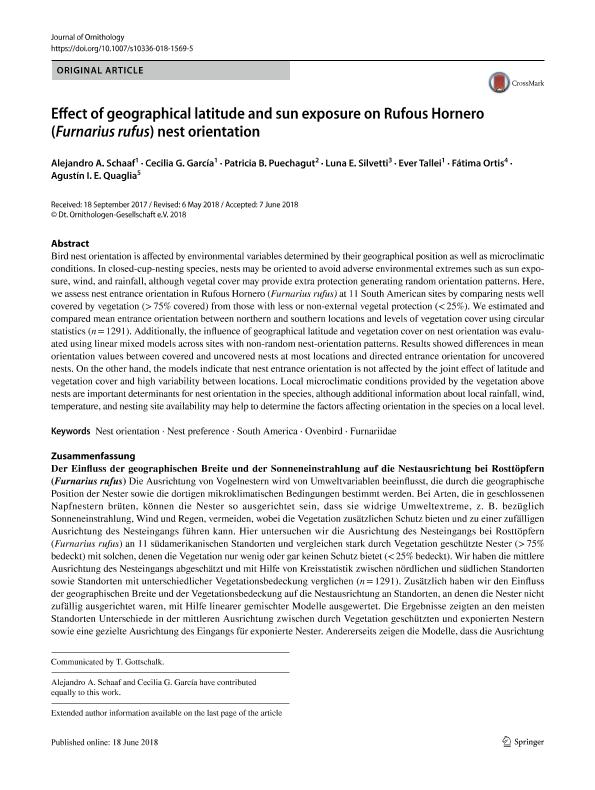Mostrar el registro sencillo del ítem
dc.contributor.author
Schaaf, Alejandro Alberto

dc.contributor.author
García, Cecilia Graciela

dc.contributor.author
Puechagut, Patricia Beatriz

dc.contributor.author
Silvetti, Luna Emilce

dc.contributor.author
Tallei, Ever Denis

dc.contributor.author
Ortis, Fátima
dc.contributor.author
Quaglia, Agustín Ignacio Eugenio

dc.date.available
2019-11-29T21:14:06Z
dc.date.issued
2018-06
dc.identifier.citation
Schaaf, Alejandro Alberto; García, Cecilia Graciela; Puechagut, Patricia Beatriz; Silvetti, Luna Emilce; Tallei, Ever Denis; et al.; Effect of geographical latitude and sun exposure on Rufous Hornero (Furnarius rufus) nest orientation; Springer Verlag Berlín; Journal of Ornithology; 159; 4; 6-2018; 967-974
dc.identifier.issn
2193-7192
dc.identifier.uri
http://hdl.handle.net/11336/91044
dc.description.abstract
Bird nest orientation is affected by environmental variables determined by their geographical position as well as microclimatic conditions. In closed-cup-nesting species, nests may be oriented to avoid adverse environmental extremes such as sun exposure, wind, and rainfall, although vegetal cover may provide extra protection generating random orientation patterns. Here, we assess nest entrance orientation in Rufous Hornero (Furnarius rufus) at 11 South American sites by comparing nests well covered by vegetation (> 75% covered) from those with less or non-external vegetal protection (< 25%). We estimated and compared mean entrance orientation between northern and southern locations and levels of vegetation cover using circular statistics (n = 1291). Additionally, the influence of geographical latitude and vegetation cover on nest orientation was evaluated using linear mixed models across sites with non-random nest-orientation patterns. Results showed differences in mean orientation values between covered and uncovered nests at most locations and directed entrance orientation for uncovered nests. On the other hand, the models indicate that nest entrance orientation is not affected by the joint effect of latitude and vegetation cover and high variability between locations. Local microclimatic conditions provided by the vegetation above nests are important determinants for nest orientation in the species, although additional information about local rainfall, wind, temperature, and nesting site availability may help to determine the factors affecting orientation in the species on a local level.
dc.description.abstract
Die Ausrichtung von Vogelnestern wird von Umweltvariablen beeinfusst, die durch die geographische Position der Nester sowie die dortigen mikroklimatischen Bedingungen bestimmt werden. Bei Arten, die in geschlossenen Napfnestern brüten, können die Nester so ausgerichtet sein, dass sie widrige Umweltextreme, z. B. bezüglich Sonneneinstrahlung, Wind und Regen, vermeiden, wobei die Vegetation zusätzlichen Schutz bieten und zu einer zufälligen Ausrichtung des Nesteingangs führen kann. Hier untersuchen wir die Ausrichtung des Nesteingangs bei Rosttöpfern (Furnarius rufus) an 11 südamerikanischen Standorten und vergleichen stark durch Vegetation geschützte Nester (>75% bedeckt) mit solchen, denen die Vegetation nur wenig oder gar keinen Schutz bietet (<25% bedeckt). Wir haben die mittlere Ausrichtung des Nesteingangs abgeschätzt und mit Hilfe von Kreisstatistik zwischen nördlichen und südlichen Standorten sowie Standorten mit unterschiedlicher Vegetationsbedeckung verglichen (n=1291). Zusätzlich haben wir den Einfuss der geographischen Breite und der Vegetationsbedeckung auf die Nestausrichtung an Standorten, an denen die Nester nicht zufällig ausgerichtet waren, mit Hilfe linearer gemischter Modelle ausgewertet. Die Ergebnisse zeigten an den meisten Standorten Unterschiede in der mittleren Ausrichtung zwischen durch Vegetation geschützten und exponierten Nestern sowie eine gezielte Ausrichtung des Eingangs für exponierte Nester. Andererseits zeigen die Modelle, dass die Ausrichtung des Nesteingangs nicht durch den gemeinsamen Efekt von geographischer Breite und Vegetationsbedeckung beeinfusst wird und die Variabilität zwischen Standorten hoch ist. Die lokalen mikroklimatischen Bedingungen, die durch die über dem Nest befndliche Vegetation zustande kommen, sind wichtige Faktoren für Nestausrichtung bei dieser Vogelart, wobei zusätzliche Informationen über örtliche Regenfälle, Wind, Temperatur und Nistplatzverfügbarkeit dabei helfen dürften, die Faktoren zu ermitteln, welche die Nestausrichtung auf lokaler Ebene beeinfussen.
dc.format
application/pdf
dc.language.iso
eng
dc.publisher
Springer Verlag Berlín

dc.rights
info:eu-repo/semantics/openAccess
dc.rights
Atribución-NoComercial-CompartirIgual 2.5 Argentina (CC BY-NC-SA 2.5 AR)
dc.rights.uri
https://creativecommons.org/licenses/by-nc-sa/2.5/ar/
dc.subject
FURNARIIDAE
dc.subject
NEST ORIENTATION
dc.subject
NEST PREFERENCE
dc.subject
OVENBIRD
dc.subject
SOUTH AMERICA
dc.subject.classification
Ecología

dc.subject.classification
Ciencias Biológicas

dc.subject.classification
CIENCIAS NATURALES Y EXACTAS

dc.title
Effect of geographical latitude and sun exposure on Rufous Hornero (Furnarius rufus) nest orientation
dc.title
Der Einfluss der geographischen Breite und der Sonneneinstrahlung auf die Nestausrichtung bei Rosttöpfern (Furnarius rufus)
dc.type
info:eu-repo/semantics/article
dc.type
info:ar-repo/semantics/artículo
dc.type
info:eu-repo/semantics/publishedVersion
dc.date.updated
2019-10-17T16:30:22Z
dc.identifier.eissn
2193-7206
dc.journal.volume
159
dc.journal.number
4
dc.journal.pagination
967-974
dc.journal.pais
Alemania

dc.journal.ciudad
Berlín
dc.description.fil
Fil: Schaaf, Alejandro Alberto. Universidad Nacional de Jujuy. Instituto de Ecorregiones Andinas. Consejo Nacional de Investigaciones Científicas y Técnicas. Centro Científico Tecnológico Conicet - Salta. Instituto de Ecorregiones Andinas; Argentina
dc.description.fil
Fil: García, Cecilia Graciela. Universidad Nacional de Jujuy. Instituto de Ecorregiones Andinas. Consejo Nacional de Investigaciones Científicas y Técnicas. Centro Científico Tecnológico Conicet - Salta. Instituto de Ecorregiones Andinas; Argentina
dc.description.fil
Fil: Puechagut, Patricia Beatriz. Consejo Nacional de Investigaciones Científicas y Técnicas; Argentina. Universidade Federal Da Santa Catarina. Centro de Filosofía e Ciencias Humanas; Brasil
dc.description.fil
Fil: Silvetti, Luna Emilce. Consejo Nacional de Investigaciones Científicas y Técnicas. Centro Científico Tecnológico Conicet - Córdoba; Argentina. Universidad Nacional de Córdoba. Facultad de Ciencias Exactas Físicas y Naturales. Centro de Zoología Aplicada; Argentina
dc.description.fil
Fil: Tallei, Ever Denis. Universidad Nacional de Jujuy. Instituto de Ecorregiones Andinas. Consejo Nacional de Investigaciones Científicas y Técnicas. Centro Científico Tecnológico Conicet - Salta. Instituto de Ecorregiones Andinas; Argentina
dc.description.fil
Fil: Ortis, Fátima. Paraguay Salvaje; Paraguay
dc.description.fil
Fil: Quaglia, Agustín Ignacio Eugenio. Consejo Nacional de Investigaciones Científicas y Técnicas. Centro Científico Tecnológico Conicet - Córdoba; Argentina. Universidad Nacional de Córdoba. Facultad de Medicina. Instituto de Virología “Dr. J. M. Vanella”; Argentina
dc.journal.title
Journal of Ornithology
dc.relation.alternativeid
info:eu-repo/semantics/altIdentifier/url/http://link.springer.com/10.1007/s10336-018-1569-5
dc.relation.alternativeid
info:eu-repo/semantics/altIdentifier/doi/https://doi.org/10.1007/s10336-018-1569-5
Archivos asociados
